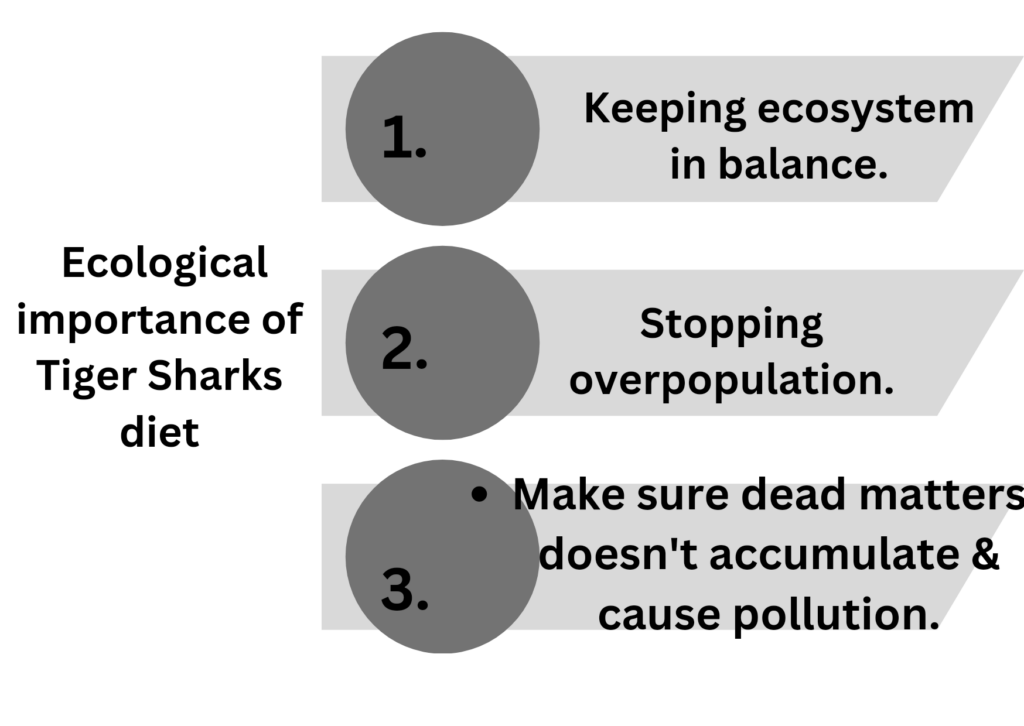
Key Takeaways
- Tiger sharks are known for their voracious appetite and will eat almost anything they come across in the ocean.
- Their diet includes a wide range of prey, including fish, turtles, seals, dolphins, and even other sharks.
- Tiger sharks have a unique ability to digest and process a variety of food items, thanks to their powerful jaws and strong stomach acids.
- They are opportunistic feeders and will scavenge on carcasses or consume garbage and human waste if it is available.
- Despite their reputation as indiscriminate eaters, tiger sharks primarily rely on their sense of smell to locate prey and are not likely to attack humans intentionally.
- The impact of tiger sharks on marine ecosystems is significant, as they help regulate populations of other species and maintain a healthy balance in the food chain.
- Conservation efforts are crucial to protect tiger sharks and ensure their survival, as they play a vital role in maintaining the health and diversity of ocean ecosystems.
Tiger sharks are fierce predators of the sea. They have powerful jaws and sharp teeth that let them eat almost anything in their path. Fish, turtles, seals – even dolphins – nothing escapes their appetite. But how true is this? Let’s explore the world of tiger sharks and find out if they live up to their name.
Tiger sharks have a diverse diet. They scavenge on carcasses or pursue live prey. They are adaptive and resourceful with their meals. But surprisingly, they can also be picky eaters. Studies reveal that they prefer sea turtles and seals. They have a strong bite to break through tough turtle shells and agility to capture fast-moving seals.
But that doesn’t mean they don’t eat anything else. They can also find dolphins and whales, tuna and groupers. Tiger sharks have an impressive ability to detect electromagnetic fields from prey underwater. Thanks to this evolutionary skill, they can find hidden food sources.
Surprising fact: tiger sharks eat just about anything – even tires and license plates!
What are Tiger Sharks?
Tiger sharks, thrilling cartilaginous fish, are renowned for their fierceness and distinct markings. With powerful jaws and sharp teeth, these apex predators have earned a reputation as opportunistic hunters. They will eat almost anything that crosses their path, from marine mammals to sea turtles and other sharks. Their exceptional sense of smell and keen eyesight assist them greatly.
Tiger sharks are most commonly found in tropical and subtropical waters, where they reign as one of the largest predatory fish. They can adapt to different environments, allowing them to live in both shallow coastal areas and deeper offshore regions. Though they prefer warm oceanic waters, they may venture into cooler temperatures.
These sharks have unique hunting skills. They “bump and bite,” using their snouts to bump potential prey before biting. This helps them assess the taste, texture, and threat of their target before eating it.
When encountering tiger sharks, caution and care are key. Respect these creatures and observe them from a safe distance.
Delve into the world of tiger sharks to gain insight into their behavior patterns and ecological significance. As they roam the oceans with adaptability and voracious appetites, tiger sharks remain an intriguing species that captivate researchers and wildlife enthusiasts. Get ready to be bitten with knowledge as we explore the feeding frenzy of these apex predators, where even leftovers have a chance of becoming the catch of the day.
Feeding Habits of Tiger Sharks
Tiger sharks – voracious eaters with a wide range of feeding habits – are known to consume fish, turtles, seals, domestic animals, and even human remains. These apex predators boast powerful jaws and serrated teeth for tearing flesh; plus, their keen sense of smell lets them detect the faintest scent of blood from miles away.
What sets them apart? Tiger sharks don’t just hunt swiftly and agilely, they also scavenge for food – taking advantage of whatever sustenance they find in their habitats. From rotting carcasses to discarded remains, nothing goes to waste.
The “Monster of Creek Road” incident in 1916 is a testament to their audacity. Along the New Jersey coast, a single tiger shark was responsible for a series of fatal attacks on swimmers – a shock to both scientists and the public. This event proved the importance of understanding the feeding habits and behaviors of these captivating creatures.
Do Tiger Sharks Eat Everything? Quite possibly! These sharks have an appetite that would surely give Jaws a run for his money.
Do Tiger Sharks Eat Everything?

Tiger sharks boast powerful jaws and sharp teeth, enabling them to effortlessly consume large prey. They can even break open the shells of sea turtles! Plus, their digestive system is impressive, allowing them to digest bone, skin, and feathers.
Their diet varies depending on geography and the availability of food sources. Generally, they feed on fish, seals, sea turtles, dugongs, and other marine mammals. They also scavenge dead animals and feast on carrion.
For those curious about tiger shark diets, here are a few ideas:
- Research their feeding habits in different regions
- Examine how environmental changes affect their diet
- Observe their interaction with other marine species
By studying these magnificent creatures, we can better understand their role in marine ecosystems and how they preserve balance.
Ecological Importance of Tiger Sharks’ Diet

Tiger sharks have a voracious appetite and play a vital role in keeping marine ecosystems in balance. They are an essential part of the food chain, and their diet has major environmental consequences.
They feed mainly on fish and marine mammals. This helps by stopping overpopulation, which can throw off the balance of marine life. And, by eating sick or weak ones, they help the ecosystem stay healthy.
Moreover, they scavenge carrion and carcasses, which makes sure dead matter doesn’t accumulate and cause pollution.
Also, they eat sea turtles. This may seem bad, but it’s actually useful, as it stops weak or sick turtles from spreading illnesses in the population.
An example of the ecological significance of tiger sharks’ diet is Shark Bay in Western Australia. Dugongs were overgrazing the seagrass meadows, which was threatening their survival. But when tiger sharks arrived, their predation on dugongs forced them to look for food elsewhere. This meant the seagrass meadows flourished again, and many species that depend on them were able to thrive.
Tiger sharks are known for eating anything that moves, so it’s no surprise that they prefer ‘bite-sized snacks!’
Misconceptions about Tiger Sharks and Their Eating Habits
Tiger sharks are often misunderstood. It’s believed they consume all that’s in sight. This isn’t true! Let’s learn more and bust some myths.
Contrary to belief, tiger sharks don’t prey on humans. They’ve been known to mistakenly attack, but it’s rare.
Tiger sharks aren’t indiscriminate predators either. They prefer certain prey like fish, turtles, seals and birds.
They’re opportunistic feeders, meaning when a carcass is around, they eat it. This leads to the idea they eat anything, but they don’t.
Age and size matter. Smaller sharks go for smaller prey, while larger ones have a bigger menu.
Despite this, tiger sharks’ behavior can still shock us. On Australia’s Great Barrier Reef, divers saw a huge tiger shark eating a whale with a turtle on its back. It’s proof their eating habits aren’t always easy to predict.
Conclusion: Tiger sharks love food, whether it’s big or small. They’re the real party animals of the ocean!
Frequently Asked Questions
Q: Do tiger sharks eat everything?
A: While tiger sharks are known for their voracious appetites, they do not eat everything. They are opportunistic predators that primarily feed on marine animals like fish, sea turtles, seabirds, and seals, but their diet may also include other sharks, dolphins, and even garbage.
Q: Are humans on the menu for tiger sharks?
A: While tiger sharks have been known to attack humans, they do not specifically target them as prey. Most incidents involving tiger sharks occur when they mistake humans for their natural food sources. These cases are rare, and the majority of encounters with tiger sharks are non-fatal.
Q: Can tiger sharks eat non-living objects?
A: No, tiger sharks do not eat non-living objects. They are carnivorous predators that rely on live prey for sustenance. However, they may accidentally ingest man-made objects like plastic or fishing gear, mistaking them for food.
Q: How much can a tiger shark eat in one day?
A: Tiger sharks have a high metabolism and can consume large amounts of food in a single day. It is estimated that a tiger shark can eat up to 100 pounds of food in a 24-hour period. Their ability to consume such large quantities of food contributes to their reputation as opportunistic feeders.
Q: Do tiger sharks eat other shark species?
A: Yes, tiger sharks are known to feed on other shark species. They are apex predators and have been observed preying on smaller sharks, including hammerheads and reef sharks. This cannibalistic behavior is not uncommon in the animal kingdom.
Q: Are tiger sharks attracted to human blood?
A: While tiger sharks have an acute sense of smell and can detect minute amounts of blood in the water, there is no conclusive evidence to suggest that human blood specifically attracts them. They are more likely attracted to the smells associated with injured or distressed animals rather than human blood alone.
Conclusion
Do tiger sharks truly eat everything in sight? Surprisingly not! Though they enjoy a varied diet, including fish, turtles, and even other sharks, plants and vegetation are off the menu. Tigers have been known to scavenge on dead carcasses, and even attack garbage or human-made objects resembling food.
To keep these apex predators alive, we must take action:
- Limiting plastic waste in our oceans can help prevent these creatures from mistakenly ingesting it.
- Establishing protected marine areas with restricted fishing can create safe havens for tigers and their prey.
We should also educate people about tiger sharks. By informing communities of their importance to marine ecosystems, we can promote conservation and gain support for their preservation.
References
https://www.nationalgeographic.com/animals/fish/facts/tiger-shark
https://a-z-animals.com/blog/what-do-tiger-sharks-eat-their-diets-explained/




